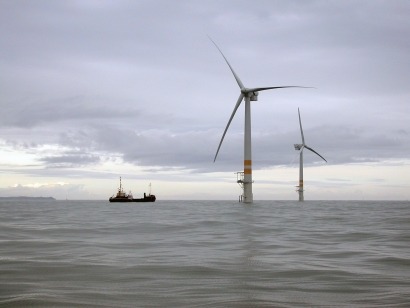
The buoy has been deployed for a six month validation period near the existing Ijmuiden met-mast, some 75 km west off IJmuiden in the Tromp Binnen wind farm area. The floating platform has a diameter of 2.8 meters and a weight of around 1.7 tonnes and is collecting data on wind, current, wave and ambient conditions. An independent analyst will evaluate the data and the results are expected to be available in the summer of 2014. The project is co-funded by FLOW (Far and Large Offshore Wind), a research and development programme sponsored by the Dutch Ministry of Economic Affairs.
The aim of the test is to find a cost efficient offshore measurement solution as an alternative for expensive fixed met-masts. The measurement data recorded by the metocean buoy will therefore be validated against the data of the IJmuiden met-mast. The buoy is equipped with a LiDAR (Light Detection And Ranging) device, a laser-based technology which is able to perform remote measurements of wind speed and direction. The SEAWATCH Wind LiDAR Buoy costs 10 to 20 per cent as much as a conventional met-mast and so makes a significant contribution to reducing offshore wind development costs.
“Wind and wave data is of fundamental importance for the development, construction and operation of offshore wind farms” said Ruben Dijkstra, Director Wind Offshore Eneco. “Affordable non-stationary equipment for accurate assessment of wind resources can improve the measuring methodology and ultimately reduce costs for offshore wind projects. After the six month testing period, we are planning to deploy the metocean buoy at our Eneco Luchterduinen offshore wind farm for a duration test of more than one year during the construction phase.”
Niels Bijkersma, Project Manager at RWE Innogy added that the test is the third such testing and validation campaign conducted at an RWE Innogy site. The first two buoys were deployed at the Gwynt y Môr offshore wind farm and the company expects to be able to demonstrate that metocean buoys are a “reliable, accurate and cost-effective alternative for recording metocean data in challenging offshore conditions over an extended period of time.”
The insights obtained from different approaches can benefit the offshore industry by improving wind farm layouts through better knowledge about load and wake effects. Metocean buoys can be used to perform wind resource assessments, to measure metocean conditions, to conduct power performance tests of wind turbines and to facilitate energy yield optimisation of operating offshore wind farms. The buoys can be easily relocated and potentially substitute multiple met-masts during their operating life.
For additional information:

